Issue:September 2022
SPECIAL FEATURE - Injection Devices: Three Trends Influencing Development & Delivery
The global injectable drug delivery market reached $15.13 billion in 2021 and is projected to reach $83.38 billion in 2030.1 Industry experts point to three key reasons why the sector is poised for such phenomenal growth. First, is the increase in self-treatment stemming from the pandemic as people chose to avoid hospital settings. “The rise in self-administration means that patients require devices that are simple and intuitive to use while fitting into their daily lifestyle,” says Michael Earl, Director, Pharmaceutical Services, Owen Mumford Ltd.
Linked to self-treatment is the second trend impacting delivery device development: digitization. The addition of connectivity provides patients with prompts, injection guidance, and dose confirmation as well as allows healthcare practitioners both access to this data and the ability to monitor and intervene as required to help improve medication compliance.
While connected electronic devices do have benefits, they also pose the challenges of appropriate disposal after use, claim industry gurus. Thus, there is an increased focus on sustainability and environmental stewardship – the third factor influencing the market. This has led to the need for devices with improved sustainability credentials, which can be demonstrated by life cycle analysis, as well as an increased focus on reusable devices as opposed to disposable alternatives.
This annual Drug Development & Delivery exclusive report showcases how various device manufacturers are addressing these trends in their injection designs.
Artcraft Health: Ensuring Certainty of Use
The development of combination medicines, biologics, and biosimilar compounds is on the rise. The successful use of these novel and life-saving drugs has become increasingly dependent on innovative and cost-effective delivery methods, such as autoinjectors, on-body injectors, and other devices that support patients’ functional and lifestyle needs.
However, along with these new developments and innovations comes the need for appropriate educational support for both healthcare providers and patients to ensure these new drugs and delivery methods are adopted, accepted, and used properly.

“We believe that tailor-made educational programs and demonstration devices are critical for long-term success,” says Marty Mason, Senior Director of Demonstration and Training Devices at Artcraft Health. “Our primary goal is to elevate and support the entire patient experience through educational onboarding initiatives involving both clinicians and patients. These factors are critical to the launch of a new or alternate delivery method.”
Artcraft Health applies educational design, adult learning principles, and a proprietary approach to health literacy during the process. “Being a leading health education and engagement agency, the company is dedicated to ensuring a therapy’s certainty of use,” says Mr. Mason. The focus, he says, is to help patients, caregivers, clinicians, and healthcare providers – who are either counseling patients or adopting new therapies and drug delivery methods – to build the skills, knowledge, and motivation they need for a successful outcome.
Artcraft Health simplifies complex delivery methods and packages them into easy-to-understand educational materials and guides patients to comply with dosing and administration. “Our holistic approach to demonstration device development and training not only provides the highest quality device but also aids in the launch strategy for commercial teams,” he says.
Services include developing demonstration devices such as prefilled syringes, autoinjectors, and on-body injectors, as well as training kits, onboarding initiatives, and educational materials across all media. Artcraft Health also provides the documentation that supports these devices, such as instructions for use, quick reference guides, packaging, cold chain logistic packaging, and training infusion kits. Current clients include AbbVie, Alexion/AZ, Amgen, Fresenius-Kabi, Merck, and Takeda.
Catalent Biologics: Design With the End User In Mind
There is increasing interest in customized designs capable of delivering a wider variety of medications, as well as more user-friendly, off-the-shelf options, says Shanna Stevens, Senior Manager, Manufacturing Technology Packaging, Catalent Biologics.
“Customization is key for patients that need a targeted approach to their treatment, and this applies to the design of features useful to both the caregiver and patient, combined with the core capabilities of the device, to optimize delivery of the injectable formulation,” she says. “This allows patients with limited dexterity to self-administer treatments as well as those who require the safe delivery of larger dose volumes.”

Designing an injector device with the end user in mind starts by knowing who will administer the drug and what the medication is treating. “If a medication is treating a person with dexterity issues, then the design must be easy to open and use, while still maintaining sterility and security through features such as tamper evidence,” says Ms. Stevens. “Additionally, some treatments require delivery of large volumes or fills that have a high viscosity, both of which can take longer to dispense. This must be considered when choosing the design and make-up of the drug delivery system.”
Congruence Medical Solutions: Innovative Devices to Solve Compelling Problems
New scientific and market “frontiers” drive changes in drug delivery, and ophthalmology is an example where frontiers are creating compelling drug delivery problems. The ophthalmic injectable pipeline has grown and diversified recently, with more target diseases (e.g., Diabetic Macular Edema, Geographic Atrophy), more potential delivery routes (e.g., subretinal, suprachoroidal), and more varied dosing frequencies. New delivery needs have therefore arisen, such as microliter dose accuracy, minimizing leachable silicone, and viscous formulations. Simultaneously, retinal surgeons want to increase patient throughput, while maintaining sterility and manual injection control.
Congruence has partnered with multiple pharma companies to address these changing ophthalmic injection needs. The result is Congruence’s Microliter Dosing Syringe (MDS) module, which attaches to any standard prefillable syringes. It improves safety, ease of use, and efficiency by enabling simple dose setting and priming, accurate microliter dosing, reduced injection force, and reduced drug waste, says Richard Whelton, Head of Marketing and Business Strategy at Congruence.

There are multiple other areas outside ophthalmology where market and scientific frontiers are creating compelling needs:
Viscous Drugs – Increasing viscosity of pharmaceutical formulations is a well-known trend, and conventional devices struggle to inject these drugs. Even non-viscous drugs may encounter similar injection issues if the drug is injected too soon after refrigeration removal or a fine injection needle is required.
“Pharmaceutical companies often increase dose volume to counter formulation viscosity, which leads to less patient-friendly delivery solutions such as multiple injections or expensive wearable injectors,” says Mr. Whelton. “This may reduce patient compliance.”
Congruence’s Viscous Dosing technology addresses this issue by enabling highly viscous drugs (up to 3000cP) to be injected in a single dose. This technology has been incorporated into a manual syringe dosing module, and a newly developed autoinjector with integrated safety and ease-of-use features for home use.
Flexible Dosing Volume – More focus is being placed on varying injectable drug dose volumes easily and accurately. Examples are potent immunotherapeutic agents that require weight-based dosing for safety and efficacy, and dose ranging studies during clinical trials. Variable dosing can also expand access, such as to pediatrics that require non-standard dose volumes. Congruence’s Flexible Dosing Syringe module delivers variable volumes over a range (50μL-2.2mL), beyond what is possible with pens, says Mr. Whelton.
Microliter Dosing – An increasing number of therapies require small dose administration, such as with targeted delivery and cell and gene therapies. “Standard syringes cannot deliver at the required accuracy, so a device such as Congruence’s MDS module is preferable,” he says. Furthermore, some small dose drugs, such as intra-tumoral and dermatology drugs, require delivery of multiple doses to the same patient. Congruence’s Microliter Multi-Dosing Syringe (MMDS) module can deliver each separate dose accurately with a simple one-step push for convenience and safety.
Credence MedSystems, Inc.: Enabling Precise Injections of Viscous Fluids
Credence has been responding to very clear trends in the novel drug delivery market for ocular and medical aesthetics applications. A shared characteristic in these markets is the use of very fine needles for injection into sensitive areas. Additionally, there is a trend towards more viscous injectables, both into the eye as well as into the face. At times, a single injection is required, while at other times multiple injections from the same syringe are warranted. Finally, certain applications require extremely low-volume injections and have the requirement for high accuracy and precision.
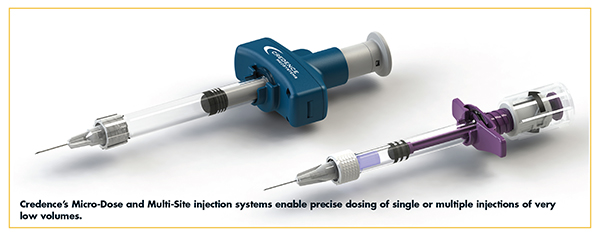
These competing requirements present significant challenges (and significant opportunities) for the device to enable a user-friendly experience that allows safe dosing. For example, the higher forces associated with injecting viscous liquids are exacerbated significantly by the requirement for fine needles. Similarly, achieving highly accurate and precise injections is more challenging with very low micro-volume doses. “Credence’s platform of Metered Dosing solutions aims to address these challenges, and in some cases, to enable the delivery of a drug that would otherwise not have been able to be successfully administered,” says John A. Merhige, Chief Commercial Officer, Credence MedSystems, Inc.
Credence’s Micro-Dose™ Injection System delivers a single injection in the micro-liter range. Applications for this can be found in the anti-vegf and gene therapy space. The Multi-Site™ Injection System allows multiple injections of a pre-determined dose, for use in toxin, filler, and dental applications. Force-Assist™ can be applied to either technology in order to reduce the force required to administer the injection to a fraction of what would otherwise be required. Mr. Merhige says: “This opens up opportunities for users to comfortably inject viscous fluids through small needles when previously the force required would have been preventative.”
He concludes: “Credence is advancing these product lines and additionally has been working with multiple pharmaceutical customers to combine various elements of these technologies into a solution that addresses the requirements of unique and novel applications.”
DALI Medical: Usability Elicits Safer Operation
Today, drug delivery solutions need to be patient-centric. Increasingly, new drugs are being developed for subcutaneous self-injection by patients and family caregivers. In response, new drug delivery devices are being designed for easy usability, high user safety, and patient comfort. To ensure patients’ and caregivers’ needs are optimally addressed, it is vital to seek their input during device development.
“Device design should include all inputs evolving out of human factors and usability studies analyses,” says Ziv Cahani, VP Business Development and Marketing, DALI Medical. “And testing should be conducted with varied user groups to ensure that all needs are considered and implemented to mitigate the risks.”
Beyond the paramount need for patient and user safety, injectable drug delivery devices are increasingly incorporating features that improve the patient experience. For example, devices are being designed with features that mitigate needle phobia and real and/or perceived pain. Additionally, digital devices provide push notifications to keep patients engaged. “By closely considering and analyzing human factors’ input, it is possible to design better drug delivery devices, i.e. devices that improve compliance,” says Mr. Cahani.

DALI Medical offers a range of advanced injectable drug delivery devices for clinical trials and commercial drugs administered by healthcare professionals and self-injected by patients and caregivers. DALI’s devices enhance safety, ease-of-use, reducing pain and perceived pain, and mitigating needle phobia, he says. DALI injection devices can be used for virtually any therapeutic area that could be treated by subcutaneous and/or intramuscular injections.
DALI device features and functionality address different aspects of the user experience that are vital to compliance, Mr. Cahani adds. “Our devices are safety-engineered to protect users and patients and provide high usability. Enabling self-injection can have a major effect on compliance as it is more convenient for patients. Supporting this, we offer devices with automatic needle insertion that facilitates self-injection and hidden needle capabilities that minimize patient anxiety.” Additionally, DALI offers devices that issue and/or display reminders and alerts that help keep patients engaged and make it easier for patients to keep up with the treatment regimen.
A customized version of DALI Medical’s SAN-Light passive safety needle enables the self-injection of a new, super-high-viscosity drug, while enabling a high level of safety and minimizing needle phobia anxiety. DALI customized its SAN-Light safety needle to meet viscosity challenges, regulatory requirements, and user preferences.
Eitan Medical: Smart, Connected Device Meets Industry Trends
‘Smart’ injection devices that allow for a more sophisticated administration experience are in demand following the development and introduction of novel injectable medications to market. Such devices need to meet specific requirements related to device performance, allowing for larger injection volumes and higher viscosities of biological drugs. In addition, devices supporting the shift from hospital to home are required as well, so drug delivery devices should be designed to meet usability aspects of the self-administration and homecare market.
Eitan Medical provides safe, intuitive, and flexible infusion and drug delivery solutions designed to address these trends. The devices aim to improve patient and clinician quality of life across the continuum of care, including in hospital, ambulatory, and home care environments, says Mindy Katz, Vice-President, Marketing and Alliance Management at Eitan Medical.
“All of Eitan Medical’s products are software-controlled, connected, electro-mechanical devices, intended to support the evolving drug delivery market,” she says.
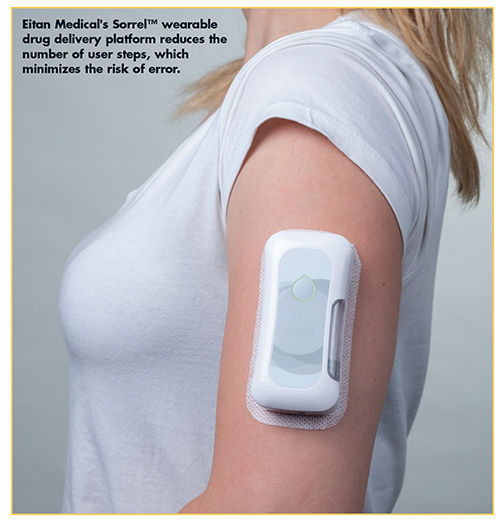
From the patient perspective, a key aspect to ensuring treatment compliance is overcoming usability challenges related to the drug delivery device. For Eitan Medical’s Sorrel™ wearable drug delivery platform, this includes reducing the number of use steps, which minimizes the risk of user error. One example of a technical feature that does just that is the internal ultraviolet LED chamber that allows for disinfection at point of care, removing the need to swab a vial or cartridge prior to drawing liquid from it. Moreover, Eitan Medical has added smart sensor technology, coupled with integrated algorithms to ensure that treatments are being delivered safely to patients in home environments. The technology provides an indication to the patient on the status of the treatment, automatically tracking a variety of technical parameters throughout the self-administration process.
In addition to designing devices that are easy for patients to use, Eitan Medical assists its pharmaceutical partners in bringing novel medications to clinical use and market sooner. Ms. Katz says: “By having the Sorrel platform conform to a variety of primary containers, pharmaceutical manufacturers can save time, risk, and cost by utilizing the primary container of their choice, whether vial, cartridge or prefilled syringe.”
Enable Injections: Improved Subcutaneous Delivery for Large-Volume Injections
Successful delivery devices have the capability to make meaningful improvements to the patient and user experience, benefitting the user by simplifying drug delivery, improving usability, and reducing potential user errors. Enable Injection’s enFuse® wearable delivery system is an innovative solution for patients to receive large-volume therapeutics subcutaneously. The enFuse elastomeric technology delivers therapeutics at a low pressure, responsive to the pressure in the subcutaneous tissue and an elastomeric reservoir doubles as the pump and allows a delivery responsive to skin backpressure.
Jennifer Estep, Senior Director, Global Marketing & Commercial Strategy, Enable, says early clinical results give relative confidence that the unique design characteristics of enFuse may translate to potential clinical benefits and show an increase in patient preference over alternative current large-volume methods of subcutaneous delivery. In a separate 488-patient preference study that looked at SC trastuzumab, 90% of patients preferred SC administration over IV, and 80% explained time savings was the greatest benefit.2 “Enable Injections’ enFuse offers flexibility and time savings compared to traditional IV administration for both providers and patients,” she says.
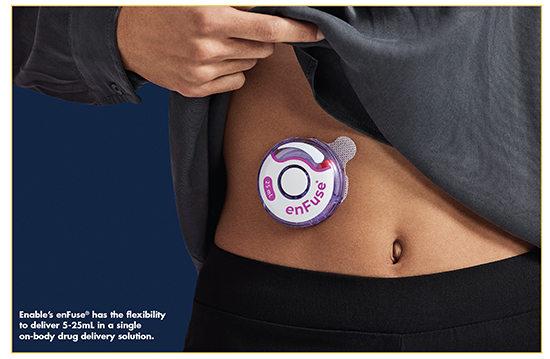
enFuse also allows a range of delivery from 5-25mL, and the needle is hidden the entire time the patient handles the device. A safety tab prevents premature button engagement, which keeps the needle hidden before injection. Once the user removes the safety tab and presses the button, the needle is hidden by the body. When treatment concludes, the button pops causing the needle to retract and lock into place, which ensures the needle is never exposed to the user.
For patients, the enFuse is discreet and can be worn under clothing and patients may go about normal activities while receiving an injection. Ms. Estep says: “New connected technologies such as the Enable Smart enFuse technology could potentially allow advanced injection data and remote monitoring for providers and caregivers.”
Flex: Connected Solutions Can Improve Patient Compliance
The FDA increasingly has reinforced the importance of usability studies in medical device design to simplify device use, reduce error, and increase utility. As it relates to autoinjector device data collection, legacy Bluetooth connectivity is being replaced by newer technologies including low power wide area networks and narrow band Internet of Things, so dependence on intermediary equipment such as smartphones is eliminated, explains Jennifer Samproni, CTO, Health Solutions at Flex.
“In simpler devices, such as disposable prefilled syringes, there is a growing need for remote patient monitoring solutions,” she says. “This is achieved by adding an intelligence layer enabled by low-cost printed electronics and connectivity solutions.”
Flex deploys internal product accelerator programs to stay ahead of medical market and technology trends such as these. One such program is its Smart Autoinjector Demo Platform, which interweaves technological advancements with simplification and user personalization. “Our goal is to create drug delivery platforms that are an extension of what the patient does naturally, factoring in grip, strength, eyesight, and composition of skin, all of which can change over time within the same user,” says Ms. Samproni. A novel method is to make the interaction user friendly across the spectrum with voice recognition technologies, which Flex has integrated into its platform.
The platform emphasizes three critical themes to improve patient compliance:
Simplicity of use: This user-centered design philosophy focuses on designing a product experience that fits with user lifestyles, behaviors, and abilities. Interviews and observations, journey mapping, and ergonomic research provide user insights that are synthesized to establish foundational design tenants for the product. Simulation of physical and digital interfaces through use of virtual reality, tablets, and user experience models accelerate feedback at early stages and enhance quality of data, ensuring a strong design direction.
Information Relevancy: Timely sharing of personalized data has a positive impact on patient outcome, which is particularly important in chronic disease management. Empowering patients by providing customized information and clinical team support increases their self-awareness and drive to adhere to their treatment plan. Supported by cloud-based analytics, the monitoring system detects patient patterns and can provide reminders and statistics. Physicians can step in remotely to provide consultation and acknowledge good performance.
Reliability: Reliable performance requires a strong quality engineering commitment from the early design phases driven by a foundational design verification and device validation strategy. Flex’s device platforms rely on advanced simulations upfront, such as radio frequency and antenna optimization for connectivity functions, comprehensive simulations for drive systems, tolerance and stress analysis for mechanical parts, and molding simulations for plastic parts. This is followed by extensive hardware and software device testing.
“Medical device engineers need to keep pace with changing dynamics in the healthcare industry, including frequently changing regulations and the need to reduce environmental impacts through sustainable design and materials across the product lifecycle,” says Ms. Samproni. “At the same time, engineers must find the balance between user needs, cost, and time to market. This drives Flex to invest in solutions that make it easier for pharma companies to deliver compliant solutions with speed and confidence.”
Gerresheimer: Devices Enable Large-Molecule Administration
Subcutaneous injection is becoming more relevant because it is generally preferred over the IV route of administration and reduces the burden and costs on the healthcare system. The need for subcutaneous drug administration is arising not only for small volumes, which could be applied through hand-held devices and pen/autoinjectors, but also for larger injection volumes, demanding more complex systems such as patchable or companion devices.
With a focus on the needs of patients and healthcare professionals for certain therapeutic areas such as oncology, immune system disorders and/or chronic diseases, the Gerresheimer device solutions are specifically tailored to fulfill the requirements of sensitive drug formulations such as biopharmaceuticals.
While Gerresheimer’s autoinjector covers a range of injection volumes from 1.5-3mL using a glass cartridge-based design, the SensAIR technology is designed to address injection of larger volumes up to 10mL or even 20mL.
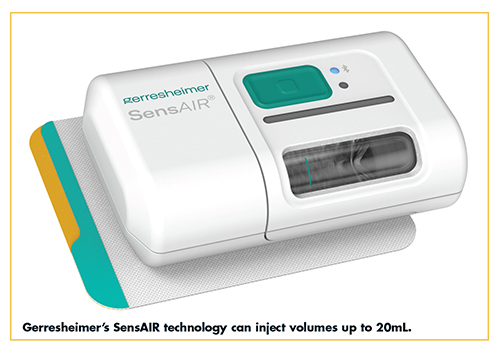
“Both concepts enable the administration of large molecule and biopharmaceuticals with different viscosities over a desired application time based on the requirements of the therapy and the drug in question,” says Reza Abedian, PhD, Senior Medical Affairs Manager, Gerresheimer.
Targeted users and relevant stakeholders of these devices, including patients and healthcare professionals, were involved in the design and development process of these devices. Dr. Abedian explains that surveys of patients with cancer, immune system disorders, and metabolic diseases, as well as learnings from interviews with clinicians and nurses, drove the device design.
Haselmeier: Injection Pen & App Impact Patient Behavior During Trials
Haselmeier, the drug delivery division of medmix, introduces the D-Flex Logbook, which complements patients´ self-injection from clinical testing to commercial launch. Frank Leipold, Vice President Product & Portfolio Management at Haselmeier, explains why the D-Flex Logbook is key to more transparency in clinical trials and how it adds tangible value during clinical testing of new drugs.
The success of clinical trials with self-injection devices relies on patient compliance. While many patients comply with their therapy, others might not or only in part. “Until now, there are only limited possibilities to check the extent of patients’ real adherence to the prescribed therapy. Clinicians mostly rely on patients’ feedback,” Mr. Leipold says. And that is one of the reasons why wearables and connected devices are increasingly finding their way into clinical trials.
In order to make clinical studies with self-injection devices more transparent, Haselmeier developed the D-Flex Ecosystem in 2020. This real-time solution enables stakeholders, like clinical research organizations, to quickly utilize real-world evidence to impact patient behavior during an on-going trial. However, this kind of ecosystem usually depends on a patients’ access to a mobile phone, either their own or an additional one provided by the investigator. Additional devices increase operational and regulatory efforts and increase overall cost of clinical testing. This is why Haselmeier developed the D-Flex Logbook, which collects injection data at the point of care without the need for a patient mobile app.

The D-Flex Logbook consists of the disposable D-Flex injection pen and the connected cap, which replaces the standard cap of the pen. Patients remove the connected cap from the injection pen, dial a dose, self-inject, and put the cap back on the pen; exactly how they would use a pen and a standard protective cap. Once the patient returns the cap onto the pen, the connected cap automatically identifies the administered dose, the current temperature and time, and stores this injection event in its internal memory. The cap can store up to 1,000 injection events.
These events can then be retrieved by study nurses or clinicians at each patients’ site visit to identify and address issues with patients during the ongoing trial. This additional information supports the interaction with patients during the on-going trial and should help to improve patient behavior.
The most important benefit of both systems, the D-Flex Logbook and the D-Flex Ecosystem, is that they allow evaluation of the legitimacy of each patients’ outcome data. “Without such a system, patient data from non-adherent patients or incorrectly stored injection pens would dilute the efficacy level of the outcome data of adherent patients, says Mr. Leipold.
In summary, he says the D-Flex Logbook provides paper-free numerical evidence for each patient, allowing study sponsors to evaluate adverse events and to exclude certain patients´ data based on real-world evidence, which should positively impact clinical outcomes of newly tested drugs.
ICON plc: Empowering the Patient
The inaccessibility of office visits and the need for social distancing at the height of the pandemic led many to begin administering their own medications via injections, accelerating previous upward trends of self-injection utilization and technologies. With a wide variety of wearables, autoinjectors, pens and even needle-free drug delivery devices in development, for many, this practice represents the patient’s ability to play an enhanced and active role in their own healthcare.
However, self-administered injection comes with its own set of patient needs and risks. These factors are informing the development of smart injection technologies and features. One of the most critical metrics for self-injectable medications is the ability for the patient to track doses. “Without adherence to a treatment plan, patients will lose the medical efficacy of self-administered injectable medications,” says Dr. Devin Ridgely, Director, Project Management, Medical Device & Diagnostics Research, ICON plc. “Forgetting doses is a prominent problem for many patients — particularly those for whom injections are so routine that it is easy to lose track of time and frequency of administration.”
To combat patient “forgetfulness,” many injection devices are utilize Bluetooth capabilities to transmit administration data to an app on the user’s phone. Smart devices can provide reminders at the appropriate time or alert the patient when a dose has been missed.
Similarly, the use of smart technology can be harnessed to reduce user error. Medications that require frequent injections increase the probability for user error, which impacts the efficacy of the treatment and overall patient health. Some connected devices offer guidance through the injection process and can detect errors, such as holding time, during administration. Other metrics that can be tracked are drug expiration dates or if the drug had a damaging temperature excursion, rendering the drug unusable/unsafe for self-administration.
“Digitally connected wearable injection devices can empower patients by helping them control their comfort and treatment plan in accordance with physician recommendations,” says Dr. Ridgley. “A variety of possibilities for smart device connectivity and feedback communications is well positioned to meet the needs of patients. As capabilities grow, clinical applications will expand, and developers will continue to adapt new features and functionality to improve the lives of those who choose to self-administer injections.”
Kahle Automation: Designing Automation That Produces Complex Devices
As home health care becomes more essential and more drugs are finding homes in wearable devices, the automation equipment for manufacturing these devices becomes more essential to meet the demands of the market. Manufacturing these complex medical devices is a challenge. The critical dimensions and performance of the devices require an automation partner that understands these constraints and provides a custom solution to meet these requirements. Working with companies from the early stages of a project allows both the product and the automation design to develop together to meet the initial production needs and the long-term high-speed manufacturing requirements with robust, proven designs.
“The biggest concern that needs to be addressed is that failure of a device in the field is not an option,” says Julie Logothetis, President, Kahle Automation. “The biggest challenge to manufacture these devices, as components are becoming smaller and smaller, is the need to feed and assemble along with 100% inspection of the assemblies as part of the manufacturing process.”
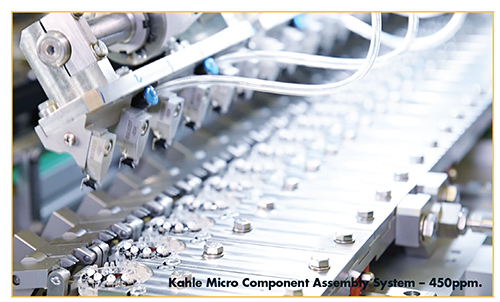
Kahle has a portfolio of designs and process solutions for the assembly and packaging of most medical devices and pharma products. Beyond creating an assembly system, Kahle validates the system and transitions the equipment into production.
“When choosing an automation partner, consider the breadth of experience a potential partner has in handling processes and parts of similar size, the flexibility of their design process to think out of the box, and the capability to evaluate process risk coupled with mitigating that risk by verifying concepts up front in a proof of principle or design of experiment,” says Ms. Logothetis. “An automation partner should be solution focused and have demonstratable experience and reputation in the medical and pharmaceutical industry to ensure innovative, robust, timely, and cost-effective results.”
Nemera: Simple & Sustainable Design
The on-body injector platform, Symbioze®, administers complex, large-volume drugs, such as monoclonal antibodies. Features include an adjustable flowrate to fit patient and drug administration profiles, near-field communications recognize the drug and verifies injection, built-in Bluetooth enables connectivity, and a reusable electronic part and disposable module.
“By offering reusable parts for multiple use, we are addressing the need for integrating sustainability into design,” says Cécile Gross, Global Category Manager, Parenteral, Nemera.
In addition to sustainable design, Ms. Gross says injection devices must maintain their ease of usability. “Simplicity of injection with a robust advanced delivery system prevents overcomplicating usage and doesn’t compromise the patient’s experience,” says Audrey Chandra, Category Project Manager, Nemera.

Symbioze addresses this need as it is ready-to-use prefilled and preloaded with a large-volume cartridge (up to 20mL), designed for patients with chronic conditions, such as Rheumatoid arthritis, psoriasis, and multiple sclerosis. “These patients require lifelong medication that enhances comfort to manage their treatment,” says Ms. Chandra. “This is particularly important when self-administering complex, large-volume high-value biologic drugs, such as monoclonal antibodies.”
Oval Medical Technologies ltd.: An Autoinjector Platform Designed for Home Use
The current trend of treatments moving from hospital to home and towards longer acting formulations have the potential to produce an improved experience for patients, with the increased convenience of fewer visits to treatment facilities and less frequent injections. However, with this transfer of treatment to the patient’s control, there is the potential for an additional burden on patients. Longer injection times and a lack of device familiarity due to infrequent injections means that delivering each injection can end up being as daunting as the first, says Barbara Lead CEO Oval Medical Technologies ltd.
“This new context of use, which can lead to injections becoming a challenging, stressful experience for patients, represents a specific set of user needs that must be addressed through careful, considerate design,” she explains.
Oval has developed ArQ-Bios, a customizable subcutaneous platform with options for both high viscosity and large-volume formulations to cater to this set of user and delivery needs. Developed with home use in mind, it provides a package that enables patients to self-administer a range of formulations that could prove challenging both from the standpoint of device capabilities and patient experience. Key features include Oval’s proprietary valve design, which allows delivery-spring release to be decoupled from actuation, leading to a gentle start of injection, with no shock from a large release of energy on actuation. As delivery progresses, the user is further supported by a 360-degree window, giving clear visibility of delivery progression from whatever angle the patient finds comfortable, removing uncertainty and worries about receiving the full dose, Ms. Lead describes.
“Throughout the user interface, every element has been carefully considered, with potential false cues and confusing elements avoided, and design inspiration taken from consumer trends giving the patient a device that feels more at home in their environment, rather than something that looks like it’s been taken straight from a hospital,” she says. “The user interface of ArQ-Bios has been developed with a core focus on usability, with elements tailored to make the injection experience simple, repeatable and stress-free in home use contexts.
Owen Mumford Pharmaceutical Services: Autoinjector Accommodates Syringe Sizes, Volumes & Viscosities
Owen Mumford Pharmaceutical Service’s Aidaptus® is a simple, two-step, single-use autoinjector platform designed for the treatment of patients who require subcutaneous medication as part of their chronic disease management. Michael Earl, Director, Pharmaceutical Services, Owen Mumford Pharmaceutical Services, says that a human factors program demonstrated that Aidaptus can be successfully used by a range of patients with varying conditions and demographics, as well as by healthcare providers. Aidaptus can be used with both 1mL and 2.25mL syringes in the same device and accommodates a variety of fill volumes and viscosities using unique auto-adjust plunger technology and a choice of two strengths of delivery springs. The design also helps to mitigate breaks in container closure integrity (CCI) by limiting rearward movement of the stopper.
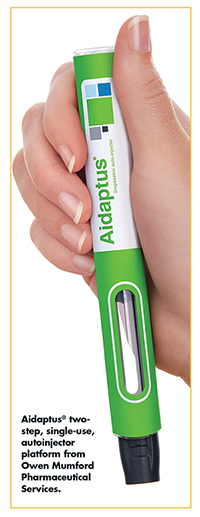
“This means the same device can be used regardless of formulation changes, which can occur in development and on through product lifecycle management,” he says. “It also minimizes for the development of multiple combination products such as validation testing, human factors studies, and regulatory submissions as well as the need for new final assembly equipment. With Aidaptus, if a pharma company’s formulation changes, the delivery device does not.”
Owen Mumford Pharmaceutical Services is collaborating with Stevanato Group on the manufacture and commercialization of Aidaptus. Stevanato Group will provide molded components and assembly equipment and is a partner in the capacity scale up and commercial roll-out for the device.
Phillips-Medisize: Mechanical & Electronics Combined Into One Autoinjector
The Aria Smart Autoinjector being developed by Phillips-Medisize is an example of combining the benefits of existing mechanical devices with new features that are realized through use of electronic devices. A basic version of the device provides a user experience comparable to that of a disposable mechanical device, with a simple user interface providing visual and audible feedback throughout; notifying when the injection is complete, avoiding the need for patients to count, explains Iain Simpson, Director, Front End Innovation, Phillips-Medisize. An advanced version, Aria+, includes a graphical interface that can support more complex drug delivery, such as partial dosing from a syringe or the use of multiple cassettes to deliver larger-volume doses. It allows adjustment of injection speed and the use of animation to provide training support.
“Compared to a spring-based system, Aria ensures gentle engagement with the syringe/stopper while delivery force is automatically adjusted to maintain a constant speed throughout,” says Mr. Simpson. “This reduces the risk of syringe breakage and shear damage to the drug, allowing optimization for a range of drugs, particularly emerging complex biologics.”
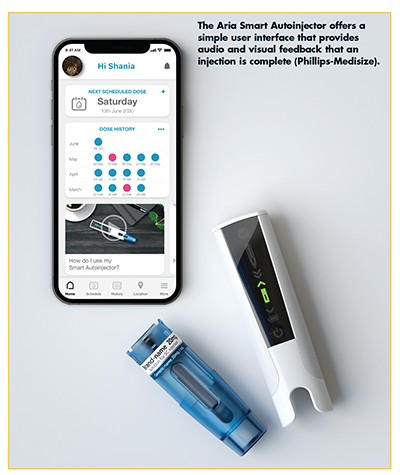
Patient compliance relies on minimal user burden and clear feedback to reduce use errors. Aria’s simple sleeve-triggered activation and large inspection window provide commonality to current single-use devices, meaning a familiar configuration for established autoinjector users and a non-intimidating experience for naïve patients, he says. Supporting companion digital services enable better patient support via an app or through remote healthcare professional support with real-time use data.
“Data from marketed electronic autoinjectors is providing evidence that adherence can be improved through smart autoinjectors,” he says. “Emerging needs around sustainability, connectivity supporting companion digital services, and flexibility around drug volume and viscosity are creating opportunities for electronic reusable autoinjectors.”
Mr. Simpson points out that Phillips-Medisize is collaborating with a pharma customer to provide a highly viscous drug that could only be delivered using a mechanical autoinjector or prefilled syringe with a much larger needle. Another customer is assessing partial dosing from a prefilled syringe to increase dosing flexibility, enabling dose titration and reducing the number of prefilled syringe SKUs required to support weight-based dosing for a broad population.
Portal: Needle-free Platform is Designed to Deliver High-Viscosity Drugs
The CDC estimates 25% of adults have a fear of needles, cites Portal. Because these fears are triggered by the presence of a needle, no easy solution to the problem exists beyond helping patients relax or avoiding injection altogether. Patients may have to accept a medication with reluctance, need someone else to administer it for them, or seek non-injectable therapies that may require more frequent dosing, dietary restrictions or a greater risk of serious adverse events.
“The lack of enthusiasm that arises from having only suboptimal device options may increase the risk of poor adherence and poor persistence on therapy,” says Patrick Anquetil, CEO, Portal. “By providing a better experience via the needle-free injector, and with its connectivity features including reminders and sharing of real-time injection data, Portal is looking to improve compliance.”
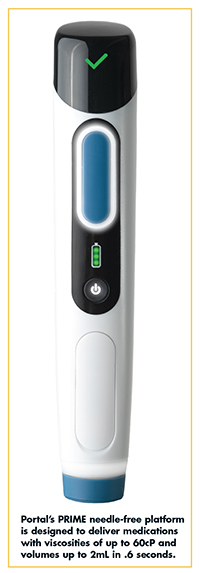
Portal is developing a needle-free injector that can handle volumes up to 2mL at high viscosities of up to 60cP in less than .6 seconds. Rick Smith, Senior Vice President of Strategy, Portal, explains that typical biologic concentrations are ≤200 mg/mL. “With increased dose needs, there becomes a trade-off between concentration, which leads to higher drug volume or to higher viscosity. New drug delivery systems are needed to handle high viscosity drugs or higher volumes in a patient-acceptable format.”
The Portal device is designed to be easy to use by the patient and can be connected to patient apps or a wellness team to provide a more complete data picture. “As more patients consult with their care team from a distance, there is a need for objective information, such as dose adherence, that can feed automatically into the patient’s digital record,” Mr. Anquetil says.
Portal’s needle-free injector is well-suited for patients with a chronic disease, who need to take subcutaneous injections on a regular basis, often at home. “The drive to divert more care to home as a lower-cost care setting has led to the need for more patients to be able to self-treat and self-inject at home. Meanwhile, the trend of more medical devices being used in the home is converging with the trend of more consumer devices looking like medical devices (wellness apps, watches). This is creating an expectation for medical devices to be as easy to use and connected like their consumer electronics and wellness tools.”
Stevanato Group: Platform Device Balances Ease of Use With Design
Platform injection devices are an off-the-shelf option that can be customized for a variety of drugs and primary packaging with minimal change components, compared to bespoke devices, which can be a huge upfront investment, says Adam Stops, Head of Product Management for Drug Delivery Systems, Stevanato Group. “Platform injection devices keep costs down and offers faster time to market, enabling patients to benefit from new therapies sooner rather than later.”
Reducing the complexity of the supply chain is also part of the device design process, he says, affecting everything from the components to the assembly procedures. Sustainability is a key factor and the supply chain for the raw materials has to be robust. “Guarantee of supply has become crucial in the wake of the disruption seen during the pandemic,” he says.
Integration is another source of innovation in injection device design to ensure devices are ready to be a combination product through integration with prefilled syringes or cartridges and manufacturing processes such as fill-finish techniques. “With such compatibility built in, the latest platform devices reduce risk and speed up time to market,” says Mr. Stops.
The SG Alina® is an example of integration. Stevanato Group designed the disposable pen-injector platform to be fully compatible with the company’s range of glass cartridges and final assembly equipment sold to customers. “This helps to ensure a robust device and dosing consistency for patients,” says Mr. Stops. “Designing the device to better fit the entire ecosystem and variability in user functions – such as dose delivery force, dose selection, and dose accuracy – help to make a difference when it comes to patient compliance.”
SG Alina is designed for variable and multi-dose treatments for conditions such as diabetes and obesity. A user-friendly, ergonomic design includes an easy-to-dial dose mechanism with an intuitive display, as well as optimized injection force for patient comfort, says Mr. Stops. Clear pre-injection dose indication is designed to avoid under dosing, with only one number visible in the dosing window at any given time to reduce the possibility of confusion; a dial-back enables dose correction. Patients also receive visual, audible and tactile feedback for dose setting, correction and injection.
A range of customization options is available for different primary packaging and therapy needs.
Individual colors can be selected, for example, for different types of insulin to help avoid patient confusion and boost compliance. And the size and position of labels, as well as the printed information itself, can be tailored according to pharma companies’ requirements.
Mr. Stops says: “SG Alina is designed to strike the right balance between pharma companies’ desire for innovation in product design and the need for familiarity to encourage patients to use a new injection device successfully.”
Vetter: Realizing Patient-Centric Devices
As a CDMO, Vetter is not only aware of what injection devices are on the market but also the differences that exist between them. This helps to create the relevant capabilities for the assembly and packaging of device systems, says Markus Hörburger, Product & Service Manager, Vetter Pharma International GmbH.
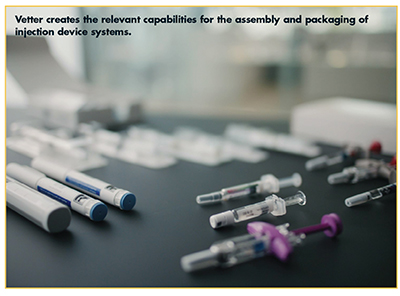
He says it is important that Vetter considers user-friendly device systems as well as the processability of the device to support successful market launches. “Our deep expertise and capabilities help our customers in realizing their patient-centric devices,” he says. “It is expected that COVID-19 will further accelerate this market shift and increase demand for home-care applications.”
Mr. Hörburger adds that patients expect a simple, safe, intuitive delivery experience that supports adherence. Thus, various delivery device designs are addressing the need to increase injection convenience. Within this context, there is also a trend toward health insurance organizations placing a greater emphasis on understanding if a drug was taken by the patient as prescribed and if it was effective. The biopharmaceutical industry is adapting to these trends by leveraging new digital solutions such as smart labels and connected devices.
West Pharmaceutical Services: Bringing Sensitive Molecules to Market in Larger Autoinjectors
With the shift of care into the hands of the patient comes the need for intuitive ergonomic design, simplicity, and the highest quality at every touch point to achieve a reliable, safe administration of the full prescribed dose. The Crystal Zenith® (CZ) 2.25mL insert needle syringe system is one such containment solution that protects sensitive molecules that are administered by an autoinjector. It is free of tungsten and glue, does not have added silicone oil added for functionality, and reduces the worry of container breakage during high-force, larger-volume injections.
“The availability of larger-volume autoinjectors, such as those which contain a 2.25mL prefilled syringe, enable patients to use a single injection per dose,” explains Dr. Nicolas Brandes, Director, Product Management, Vial Containment & PFS, West Pharmaceutical Services. “Larger volume injections are not only well accepted by patients, but it is those patient groups advocating for, and driving, change towards more choice around treatment management. West’s CZ 2.25mL insert needle syringe system will play a pivotal part in bringing sensitive molecules to market in larger autoinjectors.”
Modern biologics, such as proteins and monoclonal antibodies, exert demanding requirements on their containment system, which can be difficult for drug developers to navigate if a platform approach to packaging has been used in the past. This platform approach failed one of West’s customers, because they experienced expensive project delays when they selected their “tried and tested” large-volume, glass syringe system to package a drug to be used in an autoinjector for self-administration.
Victoria Morgan, Director, Segment Marketing, Global Biologics, West Pharmaceutical Systems, says the formulation development team picked their platform glass syringe system to package their new biologic drug in development, yet subsequent time pulls of stability samples showed the drug was silicone sensitive which, in turn, made the drug unstable. Analytical testing showed the presence of both visible silicone and protein in the drug product forcing the formulation team to reassess the primary packaging system.
“The biologic molecule required a prefilled syringe system with as low silicone oil as possible to maintain drug stability, which included both the syringe barrel and drug facing surface of the plunger,” she says. “In addition, the new containment system was expected to perform as well as a glass system with respect to functionality, which includes break loose, extrusion, and gliding forces, injection force, rigid needle shield removal force, and container closure integrity.
These were critical performance factors as the prefilled syringe system would be used within an autoinjector for the final drug delivery system.”
The customer assessed the market for a suitable syringe system and selected West’s Crystal Zenith (CZ) 2.25mL insert needle syringe system; the barrel of which doesn’t have silicone oil added for functionality, and the drug facing end of the plunger utilizes Flurotec™ barrier film for lubricity and offering a low extractables and leachables profile. Ms. Morgan says the drug was stable in the CZ syringe system and the customer was able to show better results for sub-visible particles with CZ than with glass and other polymers.
Ypsomed: Targeting Subcutaneous Delivery of Large-Volume Drugs
Demand for new device innovations for subcutaneously delivered drugs has been dominated by the need to inject larger volume injections. This has spawned demand for larger volume handheld autoinjectors and a new device class of patch injectors that adhere to the skin during injection. With regard to this development, Ypsomed offers the family of YpsoMate™ autoinjectors and the YpsoDose® patch injector.
To simplify the administration of new mAb-based cancer therapies, many of the currently approved drugs or drugs under development are targeting subcutaneous (SC) delivery. “Treating cancer, particularly during the initial stages that require surgery, radiation, and chemotherapy as well as immuno-oncology, will always be performed in the hospital environment,” says Ian Thompson, Vice President Business Development, Ypsomed. “But, even in the clinical setting there are advantages of replacing IV infusion regimens with more convenient, easy-to-prepare and administer SC therapies. Following a successful first phase of treatment that forces the cancer into remission, there will be significant demand for injectable maintenance therapies to be performed in the hospital and ultimately in the home environment.”
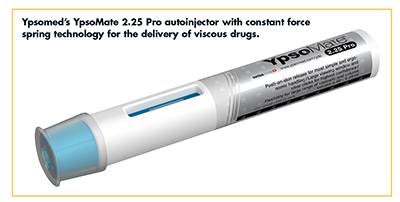
Ypsomed has developed and industrialized the handheld YpsoMate 2.25mL in two versions (standard and Pro for more viscous drugs) and the YpsoDose 10mL patch injector for large-volume SC injections. Moreover, Ypsomed is expanding the design space for rapid handheld high-volume injections. Both types of device are used for therapies that dose every week, two weeks, monthly or even less frequently. “The number of use steps and complexity must be minimized to ensure that all users will remember the correct handling even with a longer timespan between injections,” says Mr. Thompson. “Accordingly, simplicity and safety are key requirements for both autoinjectors and patch injectors.”
The 2-step YpsoMate autoinjector is triggered by push-on-skin activation, requiring two steps: remove cap and inject. The same approach is applied to YpsoDose, in which case the two steps are: patch and inject. YpsoDose is an electromechanical device with a digital user interface that ensures clear and unambiguous communication of the device status to the user, says Mr. Thompson. The integrated skin-sensing patch guarantees needle safety even in case of user errors, such as early activation of the start button or premature removal of the device from the skin.
The YpsoMate 2.25 Pro, with 2-step handling, is designed with a constant-force spring to allow reliable and reproducible injection of drug viscosities in excess of 15-20cp at room temperature.
SHL Medical: Integrating Transparency in Connected Self-Injection Devices
In the present healthcare landscape, novelty in drug delivery means self-injection systems that open pathways toward better treatment journeys for patients. Influenced in recent years, biopharma is consistently expected to prove value and effectiveness pre- and post-regulatory approvals. This means that evidence needs to be effectively communicated throughout the health ecosystem – from the payers and pharmacy benefit managers to the regulators and health authorities and so on. Connectivity requirements are now more than ever focusing on the value beyond the patient. In this context, the main intent of connectivity is to collect up-to-date research and development data as well as treatment related data and consequently, have a better understanding of the treatment process and its real-world effectiveness. Connectivity allows further refinement of the patient experience and ultimately improves treatment outcomes.
Over the years, various factors stemming from patients and treatment providers have influenced the evolution of injector device designs and their functionalities. For one, ensuring patient safety by preventing common medication errors has been an ever-present driver. “As the self-efficacy of chronic disease patients continues to increase, connected self-injection devices not only support safety of the administration process, ensuring that the right dose is taken at the right time,” says Nils Weber, Global Head of Emerging Technologies and Digital Health at SHL Medical. “This symbiotic relationship between connectivity and increased treatment adherence is extremely important in cases where dose accuracy is vital, such as in stricter or complex medication regimens like diabetes.”

SHL Medical designs and develops self-injection devices like autoinjectors and pen injectors. With its pharmaceutical partners, the company co-develops combination products for chronic diseases like Rheumatoid Arthritis, multiple sclerosis, atopic disorders, as well as diabetes. “In realizing better-connected healthcare, SHL’s digital health ecosystem builds from our innovation partnership framework to support the connectivity journey of its global pharmaceutical partners and their self-injection products,” he says. “This digital health ecosystem extends beyond the end-user device to better enable data ingestion for the optimization of therapies.”
SHL understands that integrating transparency in connected self-injection devices is key to simplifying the adherence challenges faced today. With the decentralization of treatment-related data – which allows patients transparent access to injection event data, big data analysis, as well as convenient device (fleet management) control – connected device technologies can ultimately facilitate patient adherence. Through a partnership with Innovation Zed, SHL has led digital health explorations in co-developing smart add-ons for pen injectors. The culmination from this partnership resulted in the 2022 commercialization of InsulCheck DOSE, a third-generation connected add-on that supports the monitoring of disease management regimens. InsulCheck DOSE by Innovation Zed is a Bluetooth®-powered device that transforms the traditional injection pen into a smart pen, allowing for the automated logging of injection information. In chronic disease treatment scenarios, the add-on device utilizes an OLED screen that displays the time elapsed since the last injection, shows the last dose unit, as well as indicates mounting/unmounting activities. Data from the device can be sent to a third-party software application for automated logging of injection information, which the patients can access.
“Together with our partners at SHL, we have developed a built-in firmware over-the-air (FOTA) capability for InsulCheck DOSE, which allows continuous optimization of the device’s firmware even when deployed in the field,” explains Dean Minnock, Chief Executive Officer at Innovation Zed.
“There is an untapped potential in the field of home-based treatment for connected autoinjectors,” says Mr. Weber. “With the device as an integral component of our digital health framework, together with our pharmaceutical partners, we are actively exploring connected solutions for both the clinical and commercial phases of their development projects.” These connected solutions support decentralized clinical trials, automated, real-life, and central data collection, increased data accuracy, as well as increased patient adherence with the ultimate goal of improving patient outcomes.
Duoject Medical Systems: Custom Solutions for Today’s Patient Needs
For novel drugs (as opposed to generics) there is a clear move of pharmaceutical companies towards combination devices that adapt to more complex drug requirements; i.e. specific volumes, higher viscosities, more challenging drug stability. This means that off-the-shelf device solutions increasingly require customization; while in many instances, brand new device systems are required altogether, says William Fortina, Business Development Director, Duoject Medical Systems.
He adds that there is also an increased demand for patient convenience, which translates into home-care options, self-administration with fewer and simpler user steps, and less frequent dosages. “These trends make the job increasingly challenging for device designers and producers who must simplify the user experience, while having more challenging technical requirements, and the ever-present need to control device-related costs,” says Mr. Fortina.
Duoject Medical Systems develops injection, drug reconstitution, and safety systems. Mr. Fortina says that the company has received an increasing number of enquiries in recent years for combination devices that can perform both drug mixing/reconstitution/resuspension, as well as drug injection within the same device. He says: “As a result of our client’s formulations each having their own unique requirements, we have been working on different custom solutions, based on and leveraging various existing Duoject IP. The solutions we are developing for our clients will allow convenient at-home administration for complex or unstable drug formulations, through simple and intuitive mechanisms. Simplifying the device’s operation for patients improves compliance as they are more likely to use a device that is intuitive and safe to handle.”
References
- Injectable Drug Delivery Market Size to Reach USD 83.38 Billion in 2030, Emergen Research, April 4, 2022, https://www.biospace.com/article/injectable-drug-delivery-market-size-to-reach-usd-83-38-billion-in-2030-/?keywords=covid.
- Participant Preference of Subcutaneous (SC) Versus Intravenous (IV) Herceptin (Trastuzumab) in Human Epidermal Growth Factor Receptor (HER) 2-Positive Early Breast Cancer (PrefHER), Hoffmann-La Roche, 2015.
Total Page Views: 15560









